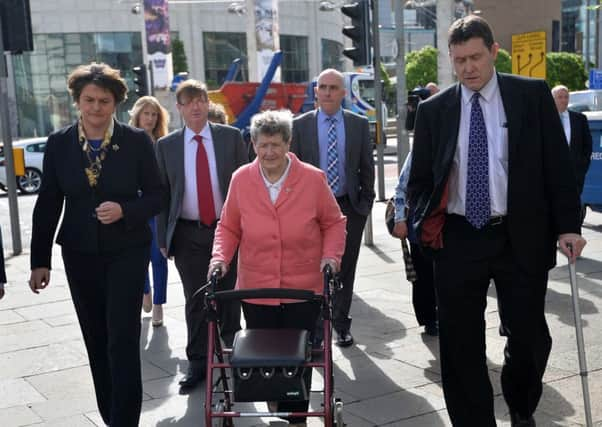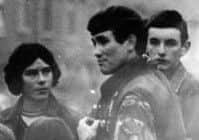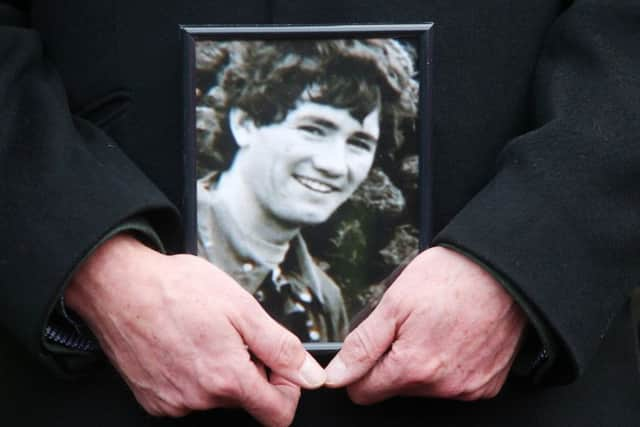Nairac link to Kingsmills '˜sensationalist fantasy'


Ten Protestant workmen were driving home from work in their minibus on 5 January 1976 when they were gunned down near Kingsmills in South Armagh. The PSNI holds the IRA responsible.
A captain from the Special Military Intelligence Unit, the witness said he had also been the longest serving army intelligence officer in south Armagh at the time. He gave evidence from behind a screen on Friday and used the cipher MOD3 in order to protect his identity.
Advertisement
Hide AdAdvertisement
Hide AdBased at Newry police station, he developed a “warm friendship” with now legendary Grenadier Guards Captain Robert Nairac, who was abducted and ‘disappeared’ by the IRA in south Armagh almost a year and a half after Kingsmills.


Efforts are still ongoing to elicit information from republicans about the location of his body for a proper funeral.
Nairac had been working for covert surveillance unit, the Northern Ireland Training and Advisory Team (NITAT), MOD3 said, and had liaised between the army and RUC.
He has been linked to Kingsmills because the gunman who led the attack spoke with an English accent. However barrister Richard Smith, acting for relatives, quoted once again from an intelligence file which said known IRA suspect S37 “almost appeared to speak with an English accent”.
Advertisement
Hide AdAdvertisement
Hide AdMOD3 rushed to the location of the attack. “The scene was the worst I had seen in the Troubles,” he said. “The sight and smell was the worst I had seen in Northern Ireland and remains with me to this day.”


He had always dismissed claims that Nairac was involved as “sensationalist fantasy” as his “integrity and moral compass” would not have allowed him to take part in such an attack.
Nairac was not in Northern Ireland at the time, MOD3 said, and if he had been he would have been told about it. If he had been “freelancing” outside the army in south Armagh at that time, he would simply have ended up being killed, he added.
Fiona Doherty QC for some of the relatives, cited detailed communications about several army “Out of Bounds” areas on the day of the shootings. MOD3 explained that he would have arranged OOBs for south Armagh to avoid ‘blue on blue’ incidents where army units stumble on each other by mistake, and to keep security force personnel safe from suspect devices.
Advertisement
Hide AdAdvertisement
Hide AdMs Doherty tried to assess if the OOBs she found had been to keep the army out of the way of the PIRA unit.


However Coroner Brian Sherarrd pointed out that Ms Dohetrty’s document referred to the Queens Lancashire Regiment in Portadown; MOD3 confirmed the regiment was based in that town at the time and not in his division.
MOD 3 said it was “almost impossible” for an outsider to visit south Armagh without being questioned and that strange cars would be noted.
Mr Smith put it to him that for Nairac to be accepted in the south Armagh IRA he would have “almost be required to take communion with them” which MOD3 affirmed.
Advertisement
Hide AdAdvertisement
Hide AdCol Marcus Simpson, a senior army personnel officer, testified that records demonstrated that in the weeks before Kingsmills, Nairac had major responsibilities helping his regiment move out of ceremonial duties in London to a new base in Surrey and in preparing for a major training exercise in Kenya, which they left to undertake eight days after the Kingsmills shootings.


Nairac had also been appointed as leader of a newly reformed Reconnaissance Platoon of 30 men in his regiment and had very heavy responsibilities to ensure his men were prepared to leave for Kenya on 13 January 1976, he said.